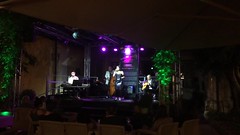I am fortunate to be enjoying my first day at NYU’s Faculty Resource Network‘s seminar on Ensuring Successful Online Learning. Our instructor is Dr. Minchi Kim, who is very pleasantly guiding a group a 20-something into Web-based learning discussions and -of course- learning. I’ll post later some more thoughts, because Kim asked to post an assignment which I am about to do just here.
Your definition and use of Instructional Technology:
Whatever technology being used/misused for educational purposes. IT aims to provide instructors with technologies suited for instruction and the good practices to put those technologies to work. Sometimes IT has been misused to sponsor some particular technology (for instance multimedia before the Web or video-disc) that was supposed to change the world of education and make it work (as if it didn’t before!). Today the term IT usually refers to computing/Web technologies in particular, so a pen wouldn’t qualify as IT, even though it is. I use IT when I 1) plan and design a course or educational material, and 2) when I am actually doing my job, and give a class, both on-line or off-line.
Your perspectives (experience) on learning, online learning, and online learning program/environments:
Let”s say I am quite interested in Web-based learning (e-learning) and the pedagogical/technological issues around it. I have directed my institution’s (Sacred Heart: www.sagrado.edu) setup effort and infrastructure in Web-based learning for over five years (I’m done with it!!!) and helped establish a Web culture there. We’ve been the first institution to adopt an Open Source learning management system (Moodle) in Puerto Rico! Recently, I have been doing research on two tracks: Distance Education as seen from the perspective of Innovation Theory (with a great group of colleagues), and another track on the relationship among Web, technology, education and media, in which I posit that the Web is a completely new territory to be appropriated by people; and try to research the fundamental principles of the new media/territory for education. I’ll post here a paper on the subject later.
I’m also offering some courses in a blended fashion at my institution, and a 6-week fully on-line seminar on Teaching On-line (which I designed) for the HETS consortium.
Your perspectives on the roles of learners and instructors in online learning environments:
I had never experienced the connection between learners and instructors better than the last time I gave the Teaching On-line course. I realized then that a small difference in the style of learners (both behavioral and cognitive) would radically change the outcome and direction of the whole course. Sometime people want to participate in a discussion, while some other time they simply do not! This taught me to “use” students who are more active as co-facilitators, in that they really help others and the course as triggers. However, the bottom line is that sometimes the difference between learner and instructor gets quite blurred!
A good example of online learning program:
I loved the original MendelWeb idea and website (from 1997!). It was based on a multi-disciplinary approach to studying the principles of genetics through Mendel’s original paper. The site used the article (both in German and English) to introduce students to probability, language, and genetics within a historic setting. It uses hypertext in an interesting fashion (quite innovative at the time). Impressive! See: http://www.mendelweb.org/.
One great site I use for educational purposes is del.icio.us (even if its main purpose is not educational). It allows one to save bookmarks and socially share them with other people. For instance, my bookmarks are at: http://del.icio.us/avunque.



